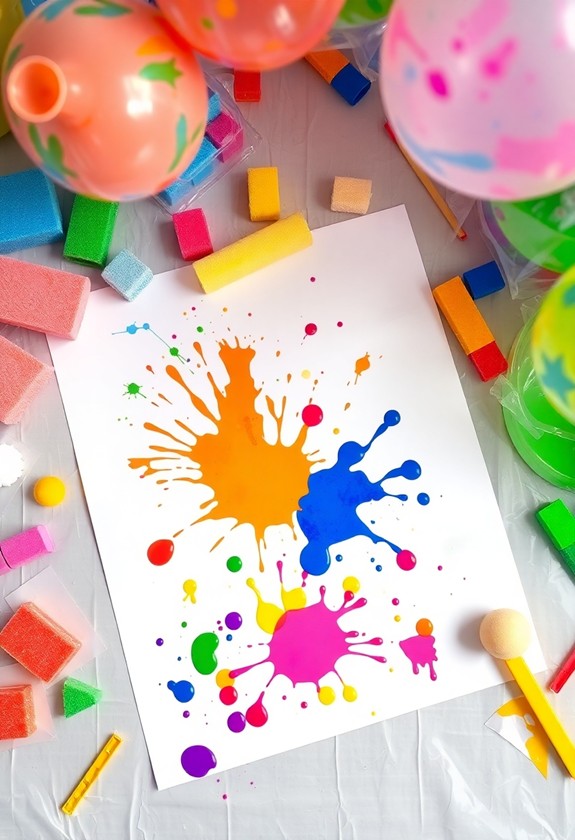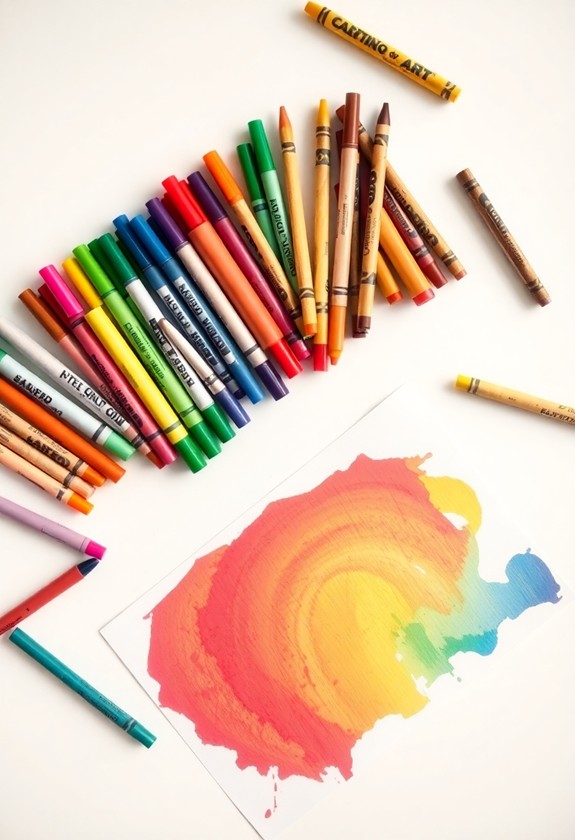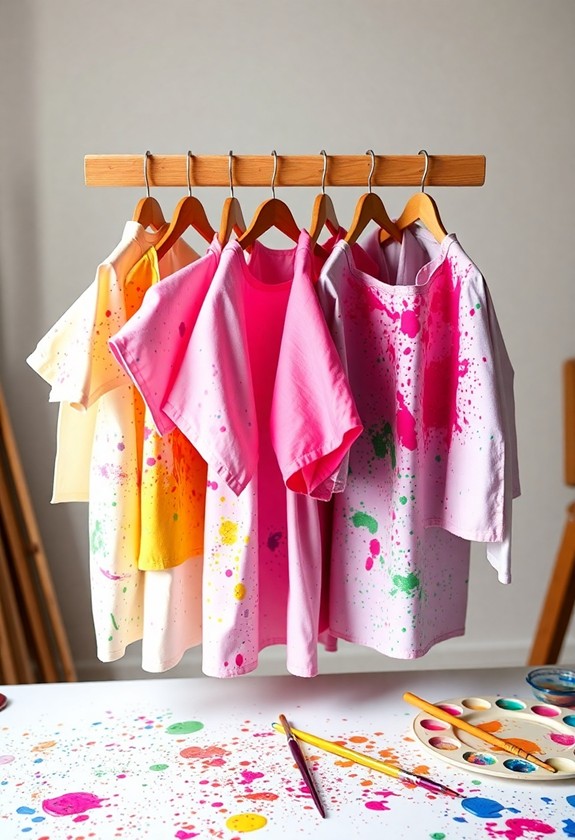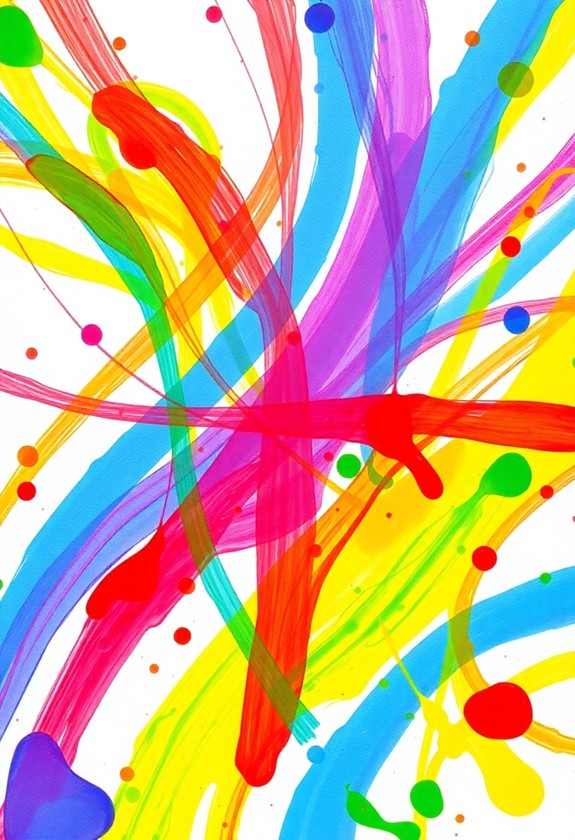Get ready for some colorful fun with these three mess-free painting activities for preschoolers! First up, try Plastic Bag Finger Painting – it's sensory play without the cleanup hassle. Next, discover Contact Paper Sticky Art, where kids can create dazzling "stained glass" masterpieces. Finally, cool off with Ice Cube Watercolor Creations, a revitalizing twist on traditional painting. These activities are perfect for developing fine motor skills and encouraging creativity, all during the time you keep your space spick and span. With easy setups and minimal materials needed, you'll be amazed at how much artistic fun can happen without a single paint splatter! Excited to immerse yourself in the colorful details?
Creative Highlights
- Plastic bag finger painting offers a no-mess option with easy setup and cleanup, promoting sensory play and fine motor skills.
- Contact paper sticky art allows for interactive collage-making, enhancing creativity and hand-eye coordination without paint spills.
- Ice cube watercolor creations provide a multi-sensory, mess-free painting experience that's refreshing for summer activities.
- All three activities require minimal materials and setup, making them ideal for quick, spontaneous preschool art projects.
- These mess-free painting activities encourage independent exploration and creative expression while minimizing cleanup time for caregivers.
Plastic Bag Finger Painting
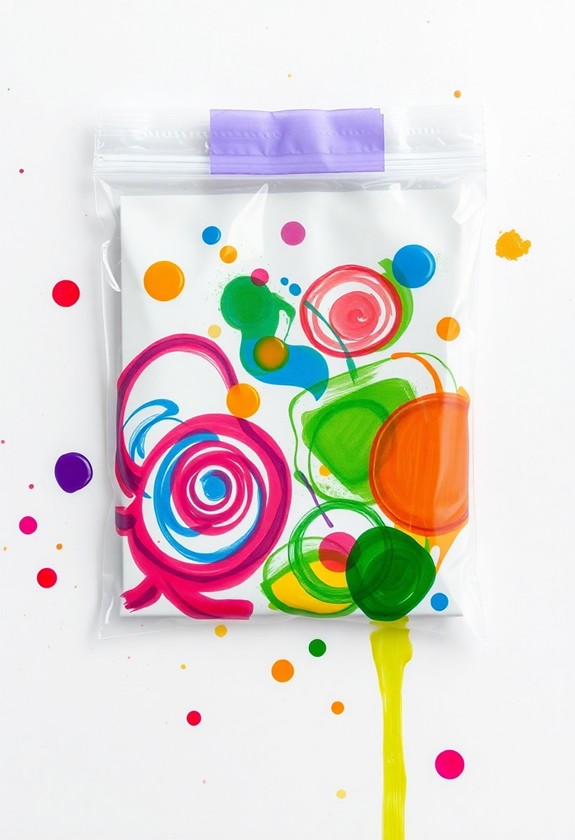
Plastic bag finger painting is a brilliant mess-free activity that'll keep your preschooler entertained for hours. It's super easy to set up, and the best part? No messy cleanup! Here's how to do it:
- Grab a large, clear plastic bag
- Squirt different colors of paint inside
- Seal it tight (double-check!)
- Tape the bag to a flat surface
Now, let your little artist go wild! They can smoosh, swirl, and squish the paint around with their fingers. The bag acts as a barrier, keeping hands clean during allowing for all the fun of finger painting. It's like magic! This activity is perfect for promoting sensory play and developing fine motor skills in young children. For added safety, consider using non-toxic, washable paints suitable for toddlers.
Want to add more excitement? Try these twists:
- Use glow-in-the-dark paint for a cosmic experience
- Add glitter for extra sparkle
- Draw shapes on the bag for your child to fill in
Contact Paper Sticky Art
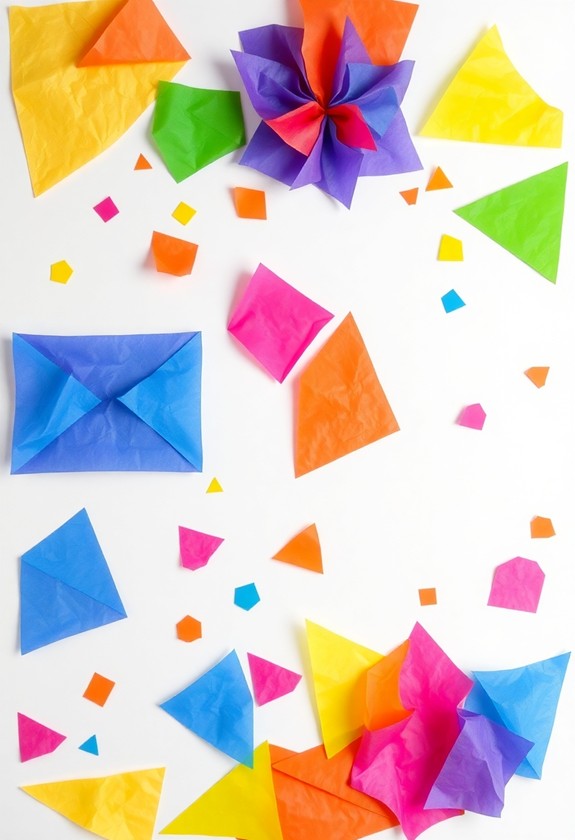
Contact paper's sticky surface transforms into a canvas for your preschooler's creativity in this engaging, mess-free art activity. It's time to get sticky with it!
Here's what you'll need:
- Contact paper
- Tape
- Colorful tissue paper, cut into shapes
- Glitter (optional)
This activity is perfect for developing fine motor skills and hand-eye coordination in preschoolers. It likewise encourages independent creativity, allowing children to investigate colors and shapes freely.
Instructions:
- Cut a piece of contact paper and tape it to a table, sticky side up.
- Let your little artist go wild! They can press tissue paper shapes onto the sticky surface.
- Sprinkle some glitter for extra sparkle (if you're feeling brave).
- When they're done, cover their creation with another piece of contact paper.
Voila! You've got a beautiful, mess-free masterpiece. Hang it in a window for a stained-glass effect. It's art that really sticks with you!
Ice Cube Watercolor Creations
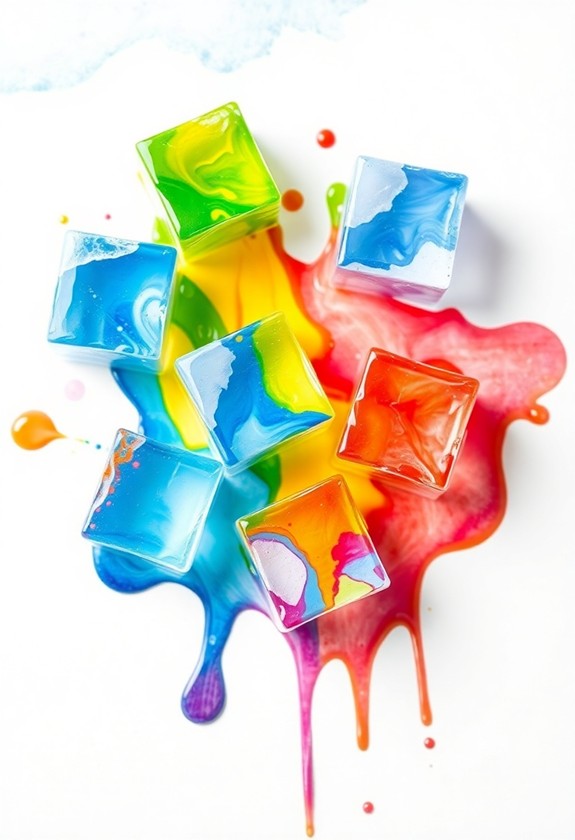
After investigating sticky art, let's cool things down with Ice Cube Watercolor Creations. This frosty activity is a breeze to set up and loads of fun! Here's what you'll need:
- Ice cube tray
- Food coloring
- Popsicle sticks
- Thick paper
Mix food coloring with water, pour into the ice tray, and freeze overnight. Pop! You've got colorful ice cubes ready to paint with. Watch as your little artists drag the melting cubes across the paper, creating swirling, icy masterpieces! This multi-sensory experience aids in memory retention and information processing, essential for early childhood development. Regular engagement in such creative activities stimulates brain regions associated with problem-solving and motor skills.
But wait, there's more! Try these cool tricks:
- Sprinkle salt on wet areas for a sparkly effect
- Use white crayon to draw "secret" pictures that appear as the ice melts
This chilly technique is perfect for hot summer days. Your kids will have a blast, and clean-up is a snap!
Curious Little Questions
What Age Group Are These Painting Activities Most Suitable For?
You're looking at activities perfect for preschoolers, typically ages 3-5! But don't worry, these fun painting projects can be adapted for younger toddlers or even early elementary kids. It's all about tailoring the complexity to your child's skill level. Remember, every kid develops differently, so use your judgment. The key is to keep it exciting and manageable! Whether they're 2 or 6, these mess-free painting activities will spark creativity and joy in your little artist. Let's get painting!
How Can I Store and Display My Child's Finished Artwork?
Like a colorful gallery bursting with joy, your child's artwork deserves a special place! You've got so many fun options to show it off:
- Create a rotating display on the fridge with magnetic clips
- Set up a clothesline with cute pegs in their room
- Frame their masterpieces for a mini art show on the wall
- Make a scrapbook to preserve memories
- Scan and create a digital slideshow
Don't forget to date each piece! It's amazing to see how they grow and improve over time.
Are These Activities Safe for Children With Sensory Sensitivities?
You'll be thrilled to know that many of these activities can be adapted for kids with sensory sensitivities. Here's the scoop:
- Use non-toxic, fragrance-free paints
- Offer brushes with different textures
- Let them wear gloves if they prefer
- Try finger painting with shaving cream instead
- Use sponges or cotton balls for a softer touch
What Skills Do Mess-Free Painting Activities Help Develop in Preschoolers?
You'll be amazed at how mess-free painting activities can boost your preschooler's skills! They're not just fun, they're fantastic for development. Here's what your little one will learn:
- Fine motor skills – gripping brushes and making precise movements
- Color recognition – mixing and matching hues
- Creativity – expressing ideas through art
- Focus and concentration – completing a task
- Problem-solving – figuring out how to create desired effects
Plus, they'll gain confidence and pride in their creations. It's a win-win situation – clean fun and learning rolled into one!
How Often Should I Introduce New Painting Activities to My Child?
Did you know that 90% of a child's brain develops by age 5? That's why introducing new painting activities is so important! You should aim to mix things up every 1-2 weeks. Keep your little artist engaged by trying fresh techniques, materials, or themes. But don't worry if you can't always do something new – repeating favorites is great too! The key is to maintain excitement and curiosity. So, get creative and have fun investigating the colorful world of painting with your child!

